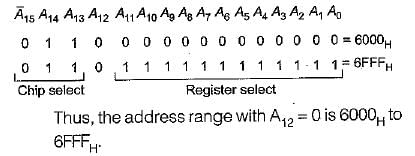Test: Microprocessor Interfacing - Electronics and Communication Engineering (ECE) MCQ
10 Questions MCQ Test - Test: Microprocessor Interfacing
The number of address lines required to address 8 K bytes of memory is
The capacity of a memory chip is 8192 bits and it has 2048 rows. Then the organisation of the chip is
The number of memory chips of size 1 K x 4-bits required to build a memory bank of size 16 K x 8 bits is
The maximum number of memory and I/O devices that can be addressed in a 8085 microprocessor based system is:
The logic circuit used to generate the active low chip select (CS) by an 8085 microprocessor to address a peripheral is shown in figure below.

The address range for which the device will respond is:
The I/O devices in 8085 microprocessor can be used in:
Eight memory chips of size 64 x 8 bits have their address buses connected together. What will be the size of the resultant memory?
Consider the following statements associated with memory mapped I/O scheme of communication with microprocessor:
1. It reduces the memory space available.
2. Arithmetic or logical operation can be directly performed with I/O data.
3. The processor cannot manipulate I/O data residing in interface registers with the same instructions that are used to manipulate memory location.
4. The processor on treats an interface register as a part of the memory system.
Which of the statements given above is/are not correct?
An 8-bit microcontroller has an external RAM with the memory map from 8000 H to 9FFF H. The number of bytes this RAM can store is:
What is the address range for 4 K RAM used in 8085 microprocessor if  's used as the chip select logic?
's used as the chip select logic?




 signal to be low, we have:
signal to be low, we have: 

 . So, the address lines A15 = 0, A14 = 1 and A13 = 1. The line A12 may be 0 or 1 and hence we will get separate range corresponding to A12 = 1 and A12 = 0
. So, the address lines A15 = 0, A14 = 1 and A13 = 1. The line A12 may be 0 or 1 and hence we will get separate range corresponding to A12 = 1 and A12 = 0

















